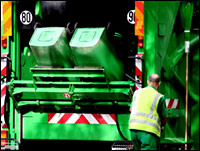Dear Umbra,
So what happens to compact fluorescent light bulbs in the hands of the “hazardous-waste people”? Is the mercury reclaimed and reused, or merely hidden “away” (wherever that is)?
John Gear
Lansing, Mich.
Dearest John,
Great question, because why should we add to the substantial mercury problem we already face? A few disillusioned readers have now sworn off compact fluorescents for this reason — the opposite of my proselytization goal.

Now what?
Photo: iStockphoto.
Let me say at the outset: your local facilities are the place to get the answer to this and other garbage-related queries. I can make general statements, but only your local waste folks know the true skinny on the type of pressing questions I see from readers, such as “Is recycling a big lie?”
However, regulations regarding bulb recycling in your state can be found at Lamprecycle.org. (“Lamp,” you ask? Remember our jargon lesson.) As you may surmise from the name of that website, the lamps are indeed recycled.
I’ll just digress one moment here and talk about hazardous waste in general. According to household hazmat sites around Our Fair Nation, hazardous waste is either recycled; blended with fuel to power things like, for example, cement kilns; plain out incinerated; or sent to a special landfill.
Mercury-filled fluorescent tubes, including CFLs, can be recycled. The process sounds a bit like all other recycling processes: a series of mechanized steps separates, sorts, crushes, and evaluates lamp components. The mercury is a central element (ha ha) of each stage in the separation. The glass and the end cap are checked for mercury residue. After all is said and sorted, the mercury is purified and re-sold. Perfect, don’t you think? Plus, new jargon: retort. A retort is a distillation vessel, and apparently also a verb, as in, “We retort the mercury in-house.”
I very much doubt that your local CFLs are sent away, because the number of businesses retorting mercury is quite high, according to my perusal. I suppose they could be making money from commercial lamps, and your local hazmat collector could be just crushing your household CFLs and chucking them into the water supply — but, again, that nagging suspicion can only be settled by calling your local hazmat people and putting the question right to them. I would expect a swift retort. Har har.
Ballastly,
Umbra

